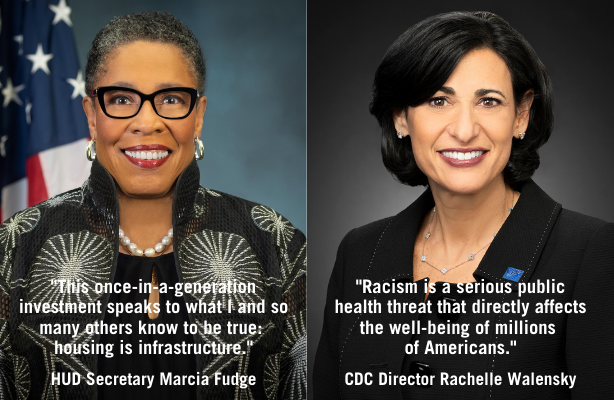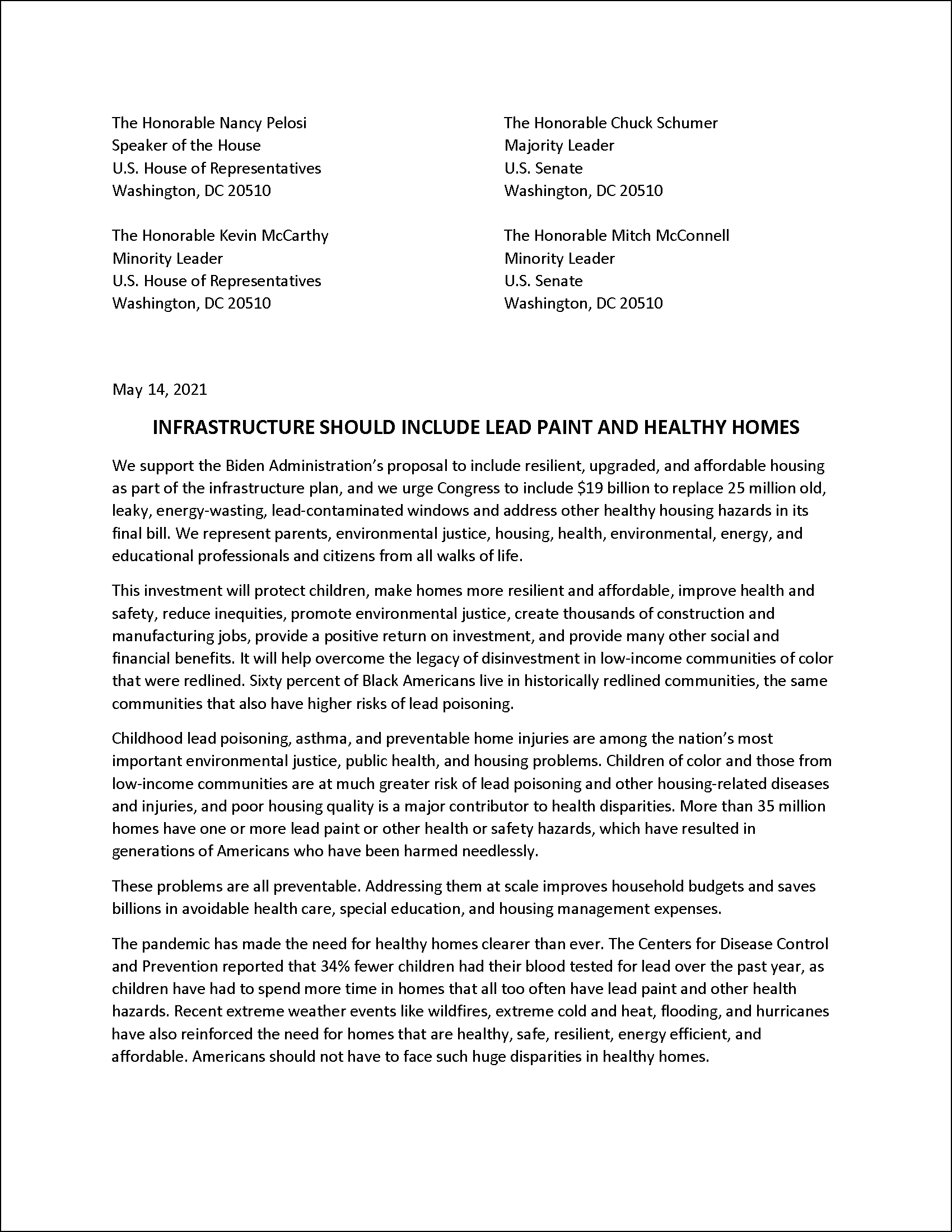Jobs, Climate, Health, Equity: The Case for (Healthy) Housing as Critical Infrastructure
by Amanda Reddy, Executive Director
Within the last month, the Secretary of the Department of Housing and Urban Development (HUD) and Director of the Centers for Disease Control and Prevention (CDC) have respectively confirmed that housing is infrastructure and that racism is a public health crisis. Taken together, these statements are a pretty accurate summation of the crisis of lead poisoning and other housing-related illness in this country and an important key to the way forward.
 For too long, we have neglected our housing stock. For most Americans, home provides security and shelter, but homes that are poorly constructed or maintained can significantly impact the health and safety of residents. An estimated 35 million U.S. homes have one or more health or safety hazards that can cause significant illness, injury, and even death; but these risks are not equally distributed across the nation. For example, Black Americans are nearly twice as likely to live in homes with severe physical problems when compared to the general population, and these disparities in housing quality drive and exacerbate disparities in health outcomes. As a result, Black children are more likely to be exposed to lead, more likely to have and die from asthma, and are at increased risk for injuries at home.
For too long, we have neglected our housing stock. For most Americans, home provides security and shelter, but homes that are poorly constructed or maintained can significantly impact the health and safety of residents. An estimated 35 million U.S. homes have one or more health or safety hazards that can cause significant illness, injury, and even death; but these risks are not equally distributed across the nation. For example, Black Americans are nearly twice as likely to live in homes with severe physical problems when compared to the general population, and these disparities in housing quality drive and exacerbate disparities in health outcomes. As a result, Black children are more likely to be exposed to lead, more likely to have and die from asthma, and are at increased risk for injuries at home.
The fact is that much more needs to be done to make homes safe, healthy, and affordable, especially among families from low-income communities. Global threats like COVID-19 and climate change haven’t created these disparities, but they have unmasked and exacerbated them. We’ve all been impacted as our underfunded public health system strained to protect us over the last year, but it is undeniable that some communities have been unfairly and unjustly burdened and that not everybody has been able to be “safer at home” if being at home means increased exposure to lead, asthma triggers, and other hazards.
It should be obvious by now that our ability to withstand future global threats—whether it be future waves of this pandemic or climate-related events like wildfires, extreme cold or heat, hurricanes, and more—urgently depends on our commitment to creating a new normal that protects all Americans before, during, and after a crisis hits. And given the central importance that housing plays in our well-being, that must include housing that is affordable, yes; resilient, absolutely; but also healthy. One could even argue that housing can be neither truly resilient nor affordable without also being healthy. After all, what’s affordable about having to miss work because of your child’s repeated asthma attacks? And how does it undermine the investment in resiliency if your home can withstand climate-related disasters but also poisons your child? Asking residents to choose between housing that is affordable and housing that is safe is unacceptable, and as advocates, practitioners, and experts, we shouldn’t be fooled into making that false choice either. We can and must provide both, and we have an unprecedented opportunity to do so before us right now.
Fortunately, we have a strong evidence base of what works to create healthier home environments, improve health, and provide real savings to the healthcare and other sectors. Based on decades of research and demonstration projects across the nation, we have strong evidence that we can prevent many health impacts by repairing and maintaining homes. We also know that these investments make sense and that each dollar invested to reduce asthma triggers at home provides a return on investment of at least $2.03, while each dollar invested in lead paint hazard control results in a return of $1.39. And it’s important to note that improving housing quality doesn’t just improve health. It also lifts up our communities through improvements in education and productivity, allowing individuals and families to thrive, and can also generate important co-benefits for other priorities like climate change and affordable and resilient housing. For example, replacing old, lead-painted windows with new energy-efficient ones eliminates a major source of childhood lead poisoning, decreases home utility bills, reduces carbon emissions by improving energy efficiency, improves home values, and creates thousands of jobs for window manufacturers and installers.

Better housing, better health: We’re asking Congress to make a $19 billion investment toward a healthier America by including in lead poisoning prevention and healthy homes activities in its infrastructure plan.
Imagine if, in 1978, we hadn’t stopped at banning lead in new residential paint, but had committed to remediating lead hazards in the millions of homes with existing lead paint. We would have prevented unnecessary lead exposure in millions of children with benefits—instead of harm—snowballing across generations. We didn’t. But there’s a saying that the best time to plant a tree is 20 (or, in our example, 40) years ago. The next best time is NOW.
We’re asking Congress to make a down payment on finishing the fight to end childhood lead poisoning while at the same time increasing the energy efficiency of 3.1 million homes, creating jobs, improving home values, lowering utility bills for families in lower socioeconomic positions, and correcting other critical health and safety hazards. You can join us by signing this letter today [update (May 14): the signature period has ended; view the finished letter and signatures here], setting us on path to protect millions of Americans and generate $26.4 billion in benefits related to lead poisoning prevention alone. The co-benefits of energy efficiency and other health outcomes will yield billions more and address several longstanding environmental justice issues.
Let’s plant the tree and make the investment that does right by both our future needs and our past injustices.
 Amanda Reddy, MS, Executive Director of the National Center for Healthy Housing, has advanced numerous initiatives, including those related to healthcare financing of healthy homes services, training and technical assistance to support the launch and growth of sustainable healthy homes programs, and the development of indicators for the HUD Healthy Communities Index. Prior to NCHH, Ms. Reddy was a research scientist with the New York State Department of Health, where she provided program evaluation, management, and technical support for the Asthma Control, Healthy Homes and Lead Poisoning Primary Prevention, Healthy Neighborhoods, and Healthy Home Environments for New Yorkers with Asthma programs. Ms. Reddy holds an MS in environmental health from the London School of Hygiene and Tropical Medicine and a BA in neuroscience from Mount Holyoke College.
Amanda Reddy, MS, Executive Director of the National Center for Healthy Housing, has advanced numerous initiatives, including those related to healthcare financing of healthy homes services, training and technical assistance to support the launch and growth of sustainable healthy homes programs, and the development of indicators for the HUD Healthy Communities Index. Prior to NCHH, Ms. Reddy was a research scientist with the New York State Department of Health, where she provided program evaluation, management, and technical support for the Asthma Control, Healthy Homes and Lead Poisoning Primary Prevention, Healthy Neighborhoods, and Healthy Home Environments for New Yorkers with Asthma programs. Ms. Reddy holds an MS in environmental health from the London School of Hygiene and Tropical Medicine and a BA in neuroscience from Mount Holyoke College.
